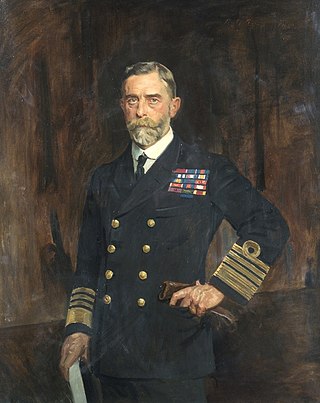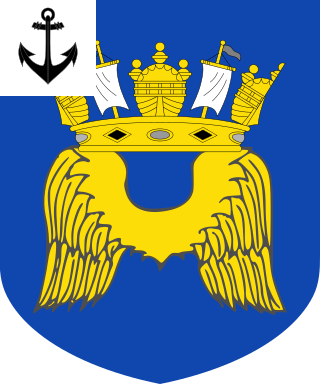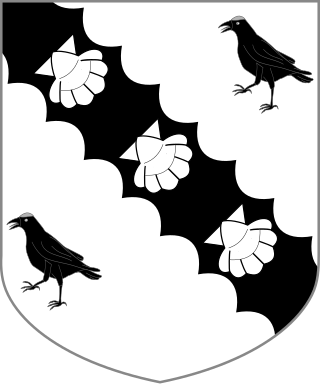
The British Mediterranean Fleet, also known as the Mediterranean Station, was a formation of the Royal Navy. The Fleet was one of the most prestigious commands in the navy for the majority of its history, defending the vital sea link between the United Kingdom and the majority of the British Empire in the Eastern Hemisphere. The first Commander-in-Chief for the Mediterranean Fleet was the appointment of General at Sea Robert Blake in September 1654. The Fleet was in existence until 1967.

Rear Admiral Sir Thomas Troubridge, 1st Baronet was a Royal Navy officer. As a junior officer he saw action at the Battle of Sadras in February 1782 during the American Revolutionary War and the Battle of Trincomalee in September 1782 during the Anglo-French War. He commanded the third-rate Culloden at the Battle of Cape St Vincent in February 1797 during the French Revolutionary Wars. He went on to be First Naval Lord and then served as Commander-in-Chief, East Indies, during the Napoleonic Wars.

Admiral of the Fleet Sir Charles Edward Madden, 1st Baronet,, was a Royal Navy officer who served during the First World War as Chief of the Staff to Sir John Jellicoe in the Grand Fleet from 1914 to 1916 and as Second-in-Command of the fleet under Sir David Beatty from 1916 to 1919. He was Commander-in-Chief of the Atlantic Fleet after the war and served as First Sea Lord in the late 1920s. In that role, in order to avoid an arms race, he accepted parity with the United States in the form of 50 cruisers defending his position on the basis that he only actually had 48 cruisers anyway.

The Anson baronetcy, of Birch Hall in the County Palatine of Lancaster, is a title in the Baronetage of the United Kingdom held by a branch of the Anson family. It was created on 30 September 1831 for William Anson. He was the third son of George Anson; his elder brothers were Thomas Anson, 1st Viscount Anson, and General Sir George Anson. Sir William was the uncle of Thomas Anson, 1st Earl of Lichfield, and Major-General George Anson and the great-nephew of George Anson, 1st Baron Anson. His grandson, the third Baronet, was a lawyer and Liberal Unionist politician. He never married and was succeeded by his nephew, the fourth Baronet. He was the only son of Frederick Arthur Anson, third son of the second Baronet. The fourth baronet drowned in the Thames on an outing of The Coterie in July 1914, after he jumped into the river encouraged by lady Diana Manners. He had not married and on his death the title passed to his first cousin, the fifth Baronet, the eldest son of Rear-Admiral Algernon Horatio Anson (1854–1913), fourth and youngest son of the second Baronet. He was killed in action in the First World War. He was unmarried and was succeeded by his younger brother, the sixth Baronet. His elder son, the seventh baronet, was a Rear-Admiral in the Royal Navy. As of 2021 the title is held by the latter's son, the eighth Baronet, who succeeded in 2018.

The Wiggin Baronetcy, of Metchley Grange in Harborne in the County of Stafford and of Garth Gwynion in Machynlleth in the County of Montgomery, is a title in the Baronetage of the United Kingdom. It was created on 17 June 1892 for Henry Wiggin. He was the founder of Henry Wiggin and Co Ltd, manufacturers of specialty metal products, and also represented Staffordshire East and Handsworth in the House of Commons. The second Baronet was High Sheriff of Staffordshire in 1896. The third Baronet was a colonel in the army and served as High Sheriff of Warwickshire in 1942. The fourth Baronet was high sheriff of Warwickshire from 1975 to 1976 and a deputy lieutenant of the county in 1985.
Stubbington House School was founded in 1841 as a boys' preparatory school, originally located in the Hampshire village of Stubbington, around 1 mile (1.6 km) from the Solent. Stubbington House School was known by the sobriquet "the cradle of the Navy". The school was relocated to Ascot in 1962, merging with Earleywood School, and it closed in 1997.

The Hammick Baronetcy, of Cavendish Square, London, is a title in the Baronetage of the United Kingdom. It was created on 25 July 1834 for the noted surgeon and physician Stephen Hammick.
The Hartwell Baronetcy, of Dale Hall in the County of Essex, is a title in the Baronetage of the United Kingdom. It was created on 26 October 1805 for Admiral Francis Hartwell.

The Price, later Rugge-Price Baronetcy, of Spring Grove in Richmond in the County of Surrey, is a title in the Baronetage of the United Kingdom. It was created on 2 February 1804 for Charles Price, Member of Parliament for the City of London from 1802 to 1812 and Lord Mayor of London from 1802 to 1803. The fifth Baronet assumed in 1874 by Royal licence the additional surname of Rugge. As of 28 February 2014 the present Baronet has not successfully proven his succession and is therefore not on the Official Roll of the Baronetage, with the baronetcy considered dormant since 2000.

The Leeds Baronetcy, of Croxton Park in the County of Cambridge, is a title in the Baronetage of the United Kingdom. It was created on 31 December 1812 for George Leeds. He was an equerry to Prince Augustus Frederick, Duke of Sussex. The Croxton Park estate in Cambridgeshire had been in the Leeds family since circa 1568. As of 2011 the presumed ninth and present Baronet, a resident of Canada, has not successfully proven his succession and is not on the Official Roll of the Baronetage.

The Seymour, later Culme-Seymour Baronetcy, of High Mount in the County of Cork and Friery Park in the County of Devon, is a title in the Baronetage of the United Kingdom. It was created on 31 May 1809 for the naval commander Admiral Michael Seymour. The second Baronet assumed the additional surname of Culme, which was that of his first wife. The third Baronet was also an admiral in the Royal Navy and notably commanded the Channel Squadron from 1890 to 1892 and the Mediterranean Fleet from 1893 to 1896. The fourth Baronet was a vice admiral in the Royal Navy.

The Buckworth, later Buckworth-Herne, later Buckworth-Herne-Soame Baronetcy, of Sheen in the County of Surrey, is a title in the Baronetage of England. It was created on 1 April 1697 for John Buckworth, High Sheriff of London in 1704. The second Baronet sat as Member of Parliament for Weobley. The third Baronet was Assistant Gentleman Usher to George II. The fifth Baronet was Gentleman-Pensioner and Exon of the Guard during the reign of George III. He married Anne, daughter of Paston Herne, of Haveringland Hall, Norfolk, and assumed by Royal licence the additional surname of Herne. The sixth Baronet assumed in 1806 by Royal licence the additional surname of Soame in compliance with the will of Sir Peter Soame, 4th Baronet, of Thurlow. The ninth Baronet was a member of the Shropshire County Council.
There have been three baronetcies created for personswith the surname Elphinstone, two in the Baronetage of Nova Scotia and one in the Baronetage of the United Kingdom. As of 2008 two of the creations are extant while one is dormant.
Eastman's Royal Naval Academy, originally in Southsea and later at Winchester, both in England, was a preparatory school. Between 1855 and 1923 it was known primarily as a school that prepared boys for entry to the Royal Navy. Thereafter, it was renamed Eastman's Preparatory School and continued until the 1940s. According to Jonathan Betts, it was "considered one of the top schools for boys intended for the Navy".
The Curtis baronetcy, of Cullands Grove, Southgate in the County of Middlesex, was created in the Baronetage of the United Kingdom on 23 December 1802 for Sir William Curtis, 1st Baronet, the son of a wealthy London biscuit manufacturer. He was member of parliament for the City of London from 1790 to 1818 and 1820 to 1826 and Lord Mayor of London from 1794 to 1795. He was later offered a peerage but declined. The third Baronet moved the family seat to Caynham Court, Caynham, Shropshire in 1852 and was High Sheriff of Shropshire in 1857. The fourth and fifth Baronets were both succeeded by cousins. The Shropshire estate was sold following the death of the sixth Baronet. The family seat is now at Bishops Waltham, Hampshire
The Sullivan baronetcy, of Thames Ditton in the County of Surrey, was created in the Baronetage of the United Kingdom on 22 May 1804 for the writer and MP Richard Sullivan. The third and sixth Baronets were Admirals in the Royal Navy. The ninth holder of the baronetcy did not use his title; as of 2023 the Official Roll marked the baronetcy as vacant.

The Scott baronetcy, of Witley in the County of Surrey, was created in the Baronetage of the United Kingdom on 3 February 1913 for the naval commander Admiral Percy Scott.

The Tyrwhitt baronetcy, of Terschelling and of Oxford, was created in the Baronetage of the United Kingdom on 13 December 1919 for the naval commander Reginald Tyrwhitt. He was a descendant of John Tyrwhitt, brother of the first Baronet of the 1808 creation. In 1934 Tyrwhitt was promoted to Admiral of the Fleet. The second Baronet was an admiral in the Royal Navy and served as Second Sea Lord from 1959 to 1961.

The Rowley baronetcy, of Tendring Hall (Stoke-by-Nayland) in the County of Suffolk, was created in the Baronetage of Great Britain on 27 June 1786 for the naval commander Rear-Admiral Joshua Rowley. He was the son of Admiral of the Fleet Sir William Rowley.

The Rowley baronetcy, of Hill House in the County of Berkshire, was created in the Baronetage of the United Kingdom on 21 March 1836 for the naval commander Admiral Charles Rowley. He was the fourth son of the 1st Baronet of the 1786 creation.